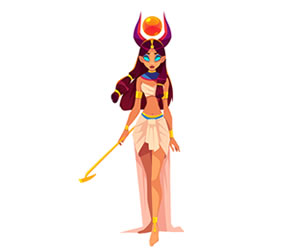Hathor is the Egyptian goddess of fertility and pleasure. She is also the goddess of joy and all things feminine. She was one of the most important goddesses in ancient Egypt and popular among royalty and common people alike. She was worshiped over several thousand years, from the early years of the ancient Egyptian religion (c. 4000 BC) until its end (c. 500 AD).
Quick Facts About Hathor
- Because of her popularity, more festivals were dedicated to the honor of Hathor and more children named after her than any other ancient Egyptian god or goddess. Her festivals were joyous affairs, filled with music and dancing;
- Hathor was not only worshipped in Egypt, but also Nubia, Semitic West Asia, Ethiopia and Libya;
- Some of the names that Hathor were called include Mistress of Heaven, Lady of Stars, Mistress of Turquoise, Lady of the House of Jubilation, and Mistress of the Offering;
- Apart from her manifestation as a cow and woman, Hathor took the form of a cat, lion, goose, and sycamore fig;
- Hathor was the patron of many things, including miners, dancers, drunkenness, and different art forms such as music. Many of her priests were artists, dancers, and musicians who contributed to the quality of life of Egyptians;
- The ancient Greeks equated Hathor with their own Aphrodite;
- It was believed that Hathor’s motherly character greeted the souls of the dead and assisted them on their final journey to a place called Duat. She even offered them refreshments from the shade of a sycamore tree;
- Hathor sometimes took the form of the Seven Hathors who were worshiped in seven cities (Lunu, Thebes, Sinai, Aphroditopolis, Keset, Herakleopolis, and Momemphis) and who were believed to know the length of every person’s life;
- The cow form of Hathor always had beautifully painted eyes. Her body was often represented in red. Together with the dwarf god BES, they were the only two gods ever pictured in portrait rather than profile;
- Hathor was viewed as the spiritual mother of the pharaoh by ancient Egyptians;
- An archeological excavation revealed ancient turquoise mining camps and a temple to Hathor in the Sinai desert. She was also worshiped at the copper mines of Timna;
- As goddess of beauty and patron of the cosmetic arts, Hathor’s traditional votive offering was two mirrors.
Origins
Dating back to the pre-dynastic era, the cow-headed goddess that appears on the Narmer Palette is said to be either Hathor or Bat, another cow-goddess with whom she was identified. Myth also has it that Hathor was a sky goddess together with Nut. They were associated with the Milky Way, which was seen as the milk flowing from the udders of a heavenly cow.
Appearance
Hathor was most often depicted as a cow or a woman with the horns or ears of a cow. In human form, a sun disk was typically placed between her horns.
Family
Hathor was closely linked to Isis, another famous Egyptian goddess who was the mother of Horus. Isis borrowed many of Hathor’s functions but was generally believed to be more merciful.
Because of Hathor’s closeness to Isis, it is perhaps not a surprise that she married Horus. When he took the form of Horus-Behdety, they had a son called Ihy, the god of music and dancing.
As time passed, Hathor’s relationships and manifestations became increasingly complex and confusing. For example, apart from her marriage to Horus, she was not only considered to be the wife and daughter of Ra at some stage, but also the mother of Ra-Horakhty, the composite deity consisting of Ra and Horus.
Powers & Duties
Hathor’s character centered around femininity. Though she had power over women’s issues such as fertility, beauty, childbirth, and love, she was also worshiped by men and even had male priests. Among others, she was celebrated as the Mistress of Life.
As part of the Eye of Ra, Hathor was a goddess of destruction. Ra sent her in the form of a blood thirsty Sekhmet to slaughter people when Ra faced criticism from the Egyptian people. However, she went from the goddess of destruction to that of love and happiness after she drank too much beer and turned her back on the killing fields.
Over time, she was associated with many other goddesses, absorbing their attributes and leading to various roles that were sometimes contradictory.
More Hathor Facts
| Name(s): | Hathor |
| Rules over: | Love, Femininity, Joy, Motherhood |
| Gender: | Female |
| Symbols: | Sun between cow horns, staff |
| Sacred animals: | Cow |
| Parents: | Neith |
| Siblings: | Sekhmet, Bastet, Maat, Shu, Tefnut |
| Greek Similar: | Aphrodite, Goddess of Love and Fertility |
| Roman Similar: | Venus, Goddess of Love and Fertility |


























